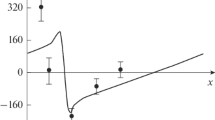Abstract
Developments of the localized hybrid method which combines an experimental technique, moiré interferometry, and a numerical method, finite-element analysis, are presented. In this localized hybrid method, the displacement fields which the moiré experiments provide in some local regions of interest are used as input data for finite-element stress analyses. Based on finite-element theory, several variations on this localized hybrid method, associated with different displacement boundary conditions, are developed. Applications and limitations of the localized hybrid method are discussed in detail. In particular, applications of the localized hybrid method of stress analysis are presented for three-dimensional problems in the mechanics of solids. It is shown that this localized hybrid analysis not only provides a powerful and efficient technique for the reduction of moiré experimental data, but also gives a good insight into the mechanics of the experimental observations.
Similar content being viewed by others
References
Segalman, D.J., Woyak, D.B. andRowlands, R.E., “Smooth Spline-like Finite-element Differentiation of Full-Field Experimental Data Over Arbitrary Geometry,”Experimental Mechanics,19,429–439 (1979).
Kobayashi, A.S., “Hybrid Experimental-numerical Stress Analysis,”Experimental Mechanics,23 (3),338–347 (1983).
Weathers, J.M., Foster, W.A., Swinson, W.F. andTurner, J.L., “Integration of Laser-speckle and Finite-element Techniques of Stress Analysis,”Experimental Mechanics,25 (1),60–65 (1985).
Chambless, D., Suhling, J., Swinson, W.F. and Turner, J.L., “A New Hybrid Photoelastic-Finite Element Technique for Stress Analysis,” Proc. 1986 SEM Spring Conf. on Exp. Mech., 991–998 (1986).
Feng, Z. andRowlands, R.E., “Continuous Full-Field Representation and Differentiation of Three-Dimensional Experimental Vector Data,”Comp. and Struct.,26,979–990 (1987).
Englestad, M.J., Chambless, D.A., Swinson, W.F. andTurner, J.L., “Hybrid Stress Analysis of Vibrating Plates Using Holographic Interferometry and Finite Elements,”Experimental Mechanics,27 (1),23–30 (1987).
Berghaus, D.G., “Combining Photoelasticity and Finite-Element Methods for Stress Analysis Using Least Squares,” Proc. 1989 SEM Spring Conf. on Exp. Mech., Cambridge, MA, 231–237 (1989).
Morton, J., Post, D., Han, B. andTsai, M.Y., “A Localized Hybrid Method of Stress Analysis: A Combination of Moiré Interferometry and FEM,”Experimental Mechanics,30 (2),195–200 (June 1990).
Guild, J., “The Interference Systems of crossed Diffraction Gratings: Theory of Moiré Fringes,” Oxford at the Clarendon Press (1956).
Post, D., “Developments in Moiré Interferometry,”Opt. Eng.,21 (3),458–467 (1982).
Guo, Y., “Developments in Moiré Interferometry: Carrier Pattern Technique and Vibration Insensitive Interferometers,”PhD Diss., Virginia Polytechnic Inst. and State Univ., Blacksburg, (Feb. 1989).
Czarnek, R., “Moiré Interferometry,”Structural Testing, SEM,30 (2),195–200 (1990).
Tsai, M.Y., “Stress and Failure Analysis of a Pin-loaded Composite Plate,” MS Thesis, Virginia Polytechnic Inst. and State Univ. (1989).
Tsai, M.Y. andMorton, J., “Stress and Failure Analysis of Pin-loaded Composite Plate: An Experimental Study,”J. Comp. Mat.,24,1101–1120 (Oct. 1990).
Morton, J. and Post, D., “Mechanics of Composites: Review of Experiments of Moiré Interferometry,” Proc. Amer. Soc. for Comp., 4th Tech. Conf., 334–344 (1989).
Wood, J.D., Tsai, M.Y., Post, D., Morton, J., Parks, V.J. and Gerstle, F.P., Jr., “Thermal Strains in a Bimaterial Joint: Experimental and Numerical Analysis,” Proc. 1989 SEM Spring Conf. on Exp. Mech., 543–551 (1989).
Tsai, M.Y. andMorton, J., “On the Stresses in a Thermally Loaded Bimaterial Interface,”Int. J. Solid and Struct.,28 (8),1053–1075 (1991).
Reddy, J.N., “An Introduction to the Finite Element Method,”McGraw-Hill, New York (1984).
Tsai, M.Y., “Application of Localized Hybrid Methods of Stress Analysis to Some Problems in the Mechanics of Composites,”PhD Diss., Virginia Polytechnic Inst. and State Univ., Blacksburg, VA (Nov. 1990).
Author information
Authors and Affiliations
Rights and permissions
About this article
Cite this article
Tsai, M.Y., Morton, J. New developments in the localized hybrid method of stress analysis. Experimental Mechanics 31, 298–305 (1991). https://doi.org/10.1007/BF02325985
Received:
Revised:
Issue Date:
DOI: https://doi.org/10.1007/BF02325985




